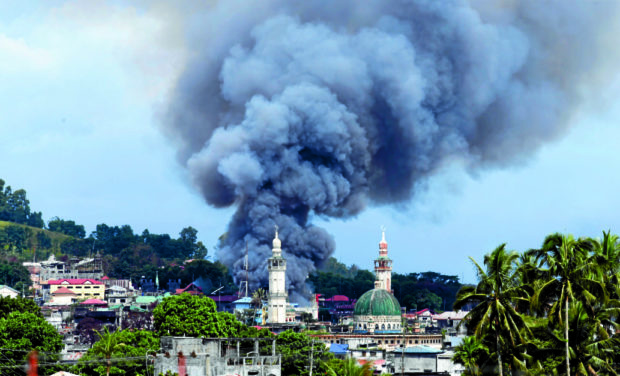
In this June 28, 2017 file photo, a bomb dropped by a military plane explodes as government troops press their assault on Maute terrorists in Marawi City. (FILE PHOTO BY JEOFFREY MAITEM / INQUIRER MINDANAO)
MARAWI CITY – The military has admitted that some Maute gunmen and those from other armed groups fighting the government here have managed to escape the war zone by posing as trapped civilians.
Lt. Col. Jo-ar Herrera, the spokesperson of the Task Force Marawi, said other gunmen probably escaped through the Lake Lanao and to areas adjoining the city.
Herrera made the admission when asked to explain his claim that only about 80 gunmen remained inside the war zone as of this week.
It was pointed out to him that if the number of slain gunmen was 366 based on latest military report and the remaining terrorists numbered 80, the total would only be about 440, a far cry from the estimate that there were about 700 terrorists who laid siege to the city on May 23.
He said the 700 was just an estimate but readily admitted that some gunmen have indeed escaped.
But Herrera clarified that the successful escape of some gunmen from the war zone happened in the early days of the fighting, “probably in the first two weeks or so.”
“I think during the first two weeks, when we were still not in control of Lanao Lake and adjacent parts of Marawi. There was a possibility that they escaped using (these routes),” he said.
Sources said among those who had successfully fled was Abu Sayyaf leader Isnilon Hapilon
But Herrera said suspected terrorists – who pretended to be trapped civilians in the latter days of the crisis – have been intercepted during processing conducted by the police’s Criminal Investigation and Detection Group (CIDG).
He said some of them tried to escape using the peace corridors established by the government and the Moro Islamic Liberation Front (MILF), but they were intercepted during interviews by the CIDG.
Herrera could not say how many suspects have been intercepted, but he said the number of recovered firearms which were left behind the main battle area, could help indicate the number of armed men who had fled the fighting.
“On the third week, we tightened the process more and cordoned Lake Lanao. We were able to negate the possible exit of the terrorists,” Herrera said.
Saripada Pacasum, the head of the Lanao del Sur provincial risk reduction and disaster management office – which had been active in the rescue of trapped civilians, agreed with Herrera that there were indeed gunmen who have escaped when the process was not yet in place.
“I think that was the case during the early days,” he said.
Pacasum said his team, for example, had just plucked out people without asking for their identities.
“Our motto is to help anybody who asked to be rescued. We prefer civilians but we can’t choose whom to rescue,” he said.
Pacasum said with the tightened process, it would be more difficult now for gunmen deserting their posts to pose as trapped civilians.
“The CIDG interviews them and those who are highly suspicious undergo further interviews. Those who had been cleared were allowed to go but others had been detained because they were suspicious,” he said.
Pacasum also said they have been rescuing civilians, and recently, they plucked out four men who had worked here as construction workers.
He said the four men have already been sent home after the CIDG found no indication they fought alongside the Maute gunmen. SFM